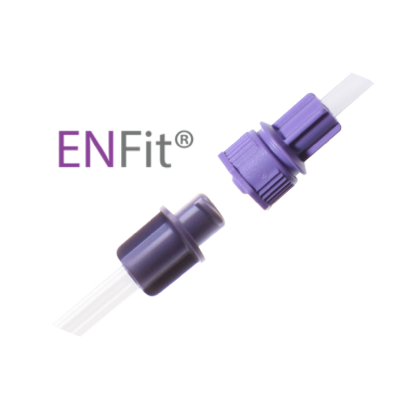Safe practices for enteral nutrition therapy may improve patient care
Enteral nutrition (EN) is an integral part of clinical intervention for paediatric and adult patients unable to consume adequate calories on their own. In the hospital and homecare settings, the implementation and observance of care protocols help maximize the benefits of EN while minimizing potential risks. This includes selecting the appropriate medical devices as well as following daily care and hygiene recommendations on an ongoing basis.
This article presents an overview of the American Society for Parenteral and Enteral Nutrition (ASPEN) and European Society for Clinical Nutrition and Metabolism (ESPEN) guidelines on safe practices for enteral access medical devices, including pump and gravity sets, feeding tubes and syringes. The full articles can be accessed via their respective websites: ASPEN, ESPEN.
Selecting the appropriate medical device
- Give preference to systems that require minimal handling.
- Use a closed EN delivery system when possible.
- Utilize enteral devices with enteral connectors that comply with ISO standards 80369-3 (ENFit).
Promoting patient safety through a unique enteral-specific design
ENFit is an ISO standard for enteral feeding devices. ENFit connectors are designed to be IV incompatible to help promote patient safety and avoid accidental misconnections.

Enteral Nutrition Administration
- Follow the manufacturer’s recommendations for duration of infusion through an intact delivery device (container and administration set).
- If open systems are used, follow recommended hang time and avoid topping remaining formula, which may result in a continuous culture for exponential microbial growth.
- Limit infusion time for open EN feeding systems to 4-8 hours maximum (12 hours in the home settings).
- Limit infusion time for a reconstituted powder product or modular to 4 hours maximum.
- Low-flow rates combined with high-dose setting may exceed the life of the disposable set and should be replaced every 24 hours to maintain delivery accuracy, allow proper air and occlusion sensing, and prevent growth of bacteria. Therefore, avoid programming a rate and dose combination that exceeds a 24-hour feeding regimen.
- To maintain tube patency, tubes should be flushed with water before starting and after completion of feeds in case of bolus administration or 4-hourly if continuous feeding.
- The necessity and appropriateness for a drug to be administered through an enteral tube should be confirmed. Drugs may be administered individually through an enteral feeding tube, and the tube flushed before, between and after each drug.
- Consider whether microbial growth related to EN might be implicated as part of the diagnosis when patients have adverse condition such as diarrhea.
Daily Care of medical devices
- Use effective hand hygiene in all aspects of EN preparation and administration. When gloves are used, they must be clean gloves, not having been involved in other non-related tasks.
- Keep all equipment, including syringes and containers for flushing and medication administration, as clean and dry as possible. Store clean equipment away from potential sources of contamination.
- Change the delivery device (container and administration set) according to the manufacturer’s recommendation for open systems.
- Do not reuse the enteral delivery device for open or closed systems (container and administration set) in excess of what is recommended by the manufacturer.
For more information about the Compat Range of Enteral Access Medical Devices please search our products or contact us directly.



